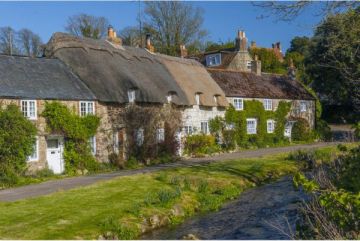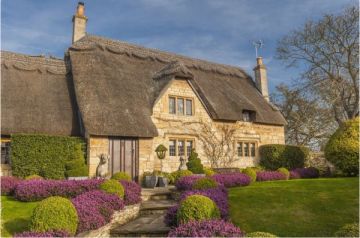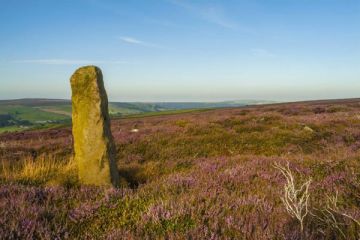CONTENT
1. Eltham Palace award
2. Hill Figures Homepage
3. London with Kids - part 5
4. UK Travel news and tips
Welcome friends, its time to put the kettle on, settle into a comfortable armchair, and enjoy the best of Britain with Britain Update. But before you do, please take the time to forward this newsletter to someone who loves Britain as much as you do.
David Ross, Publisher
******************************
Eltham Palace
******************************
Eltham Palace is one of London's unknown attractions - and one of its best. The Tudor palace was recently voted the capital's best Small Attraction in the London Tourism Awards.
The palace was built in 1305, and was for some time the childhood home of Henry VIII. The Tudors eventually abandoned Eltham in favour of Greenwich, and the buildings slumbered on in a state of disrepair. Eltham fell into private ownership, and in the 1930s the palace was remodelled in extravagant Art Deco style. In 1995 English Heritage took over management, and restored the house and garden to its 1930s Art Deco splendour, though the Great Hall of 1480 is intact, with its remarkable hammer-beam roof.
Located at Court Road, Eltham, SE9. Access by rail to Eltham station
******************************
Britain on the Web
******************************
If Ancient Britain is your cup of tea, you'll enjoy the Hill Figures Homepage at www.homeusers.prestel.co.uk/hows/personal/hillfigs/
It's an enjoyable look at ancient (and some modern imitation) hill figures throughout Britain. The site offers photos, locations, maps, suggested itineraries, links, and information on figures in need of restoration.
******************************
UK Travel Tips
******************************
ON THE ALE TRAIL IN SHROPSHIRE
Poet and 'A Shropshire Lad' A.E. Housman famously proclaimed: "Ale, man, ale's the stuff to drink", so he would approve of a new leaflet called "Looking at Shropshire through a Glass". It features eight real ale micro-breweries in this green and peaceful county close to the Welsh border and refers to 11 cosy country pubs, 30 circular walks, five leading food and drink festivals and a history of brewing which stretches back hundreds of years. The leaflet is available free from SSTA, Stone House, Corve Street, Ludlow, Shropshire SY8 1DG.
CLASSIC CAR TOURING
You can explore South East England in a classic British saloon or sports car, with the help of a Kent-based company. Heritage Car Hire has a fleet which includes a 1965 Daimler V8 automatic; a 1966 Series 1 Jaguar E-type; a 1961 Austin Healey 3000; and an MGB convertible. Prices, including insurance and tax, start at £100 per day, and there are special weekend rates. The company can also arrange local hotel accommodation, and the vehicles can be picked up at their base - where other cars can be securely stored.
For further information, contact Heritage Car Hire Limited, Unit 6, Goblands Farm, Cemetery Lane, Hadlow, Tonbridge, Kent TN11 OLT
Web site: http://www.heritagecarhire.co.uk.
Tonbridge is 32 miles from London, and within easy reach of many of the area's finest stately homes
*************************************
London with Kids - part 5
*************************************
This is the fifth in Geri Wagner' six-part series on London with Kids (see below for links to the first three parts).
DAY FOUR ITINERARY
Tower of London
Tower Bridge
Butler's Wharf
London Dungeon OR Livesey Museum for Children
Southwark
Pie and Mash
Globe Theatre
Your fourth day in London and you're not broke yet?
Tell the kids that today's excursions will be better than any scary movie on TV.and all true! You'll have some great ideas for ghost stories tonight at the hotel, believe me! One of the things we like to do with storytelling is put some sentences or phrases in a hat, related to the topic. Then, each participant pulls a slip of paper out of the hat and adds to the story, begun by the first person that uses his or her phrase! If you have little ones not yet reading, just give them a good punch line or phrase like ".there was a bloodcurdling scream." They'll do wonders with it.
If you've brought along a tape recorder, be sure to turn it on to record while your story unfolds. You may be pleasantly surprised at the results! Our kids still remember our made-up stories from sessions around campfires and fireplaces!
Tower of London
From Leicester Square, take The Circle/District Line to Tower Hill, London, EC3N 4AB Admission: £11.00 (Adults) £7.30 (Children)
Now, the Tower of London is really a, you know, museum, but your kids will hardly realise it, nor will you.
The Tower has been a palace, prison, treasury, arsenal and even a zoo! And Tower Hill, the area outside the walls was the scene of many executions and today the site of the scaffold is marked by a memorial. Some 125 Tower prisoners died here, most by beheading.
One of the most fortified buildings in the world, the Tower of London was begun in 1078 by William the Conqueror. Castle building was an essential part of the Norman Conquest. Following Duke William of Normandy's invasion of England in 1066, he and his supporters began building hundreds of castles, first to conquer, then subdue and finally to colonise the whole of England. These fortifications included the White Tower, the future Tower of London, one of the most fearsome castles of all. The Tower's history is certainly a bloody one. State prisoners such as Guy Fawkes, Sir Thomas More and the Scottish rebel William Wallace were all imprisoned and executed at the Tower. The doomed would pass through Traitor's Gate from the Thames to await their fate. Many of the prisoners in the Tower were members of the Royal Family. Lady Jane Grey, Queen for nine days in 1554, was both proclaimed monarch and executed within the grounds of the tower. Edward IV imprisoned King Henry VI after he seized power in 1465 during the Wars of the Roses.
Henry VIII had two of his wives beheaded at the tower - Anne Boleyn and Catherine Howard. The ghost of Anne Boleyn is said to haunt the battlements of the tower even today. Perhaps the most tragic murder to have taken place at the tower was during the Wars of the Roses. The Bloody Tower is thought to have been where Edward V and his brother Richard were smothered in their sleep on the orders of either Richard III or Henry VII. Between 1190 and 1285 the White Tower was encircled by two towered curtain walls and a great moat. This was followed in the 14th century by the construction of the Wharf. During this period the Tower provided the monarchy with a place of refuge against things like the 1381 Peasants Revolt which forced the 14-year-old King Richard II to shelter in the Tower with his family and household while over 10,000 rebels plundered and burned the capital for two days.
Following the Reformation (when Henry VIII broke with the Church in Rome), the Tower took on an expanded role as the home for a large number of religious and political prisoners. These included such illustrious figures as Sir Thomas More, Thomas Cromwell, two of Henry VIIIôs wives: Anne Boleyn and Catherine Howard, and his daughter, Princess Elizabeth (the future Queen Elizabeth I). A few, if not all of them, lost their heads at the Tower. Literally.
But there's a bit of comic relief, so to speak, by the Yeoman Warders, or "Beefeaters." These colourful characters have been at the Tower of London since the 14th century. Today they combine their traditional ceremonial role with that of tourist guide, telling great tales on subjects such as prisoners of the Tower.
Legend has it that Charles II was told that if the Ravens left the Tower, the monarchy would fall; so he ensured that a limited number would be kept here permanently. The Ravens are cared for by one of the Yeoman Warders, with the title of Ravenmaster. Their lodgings, next to the Wakefield Tower, can be visited.
Perhaps the most foreboding sight is the armour collection. The Royal Armouries derive from the great arsenal at the Tower, which supplied armour and weapons to the medieval English kings and their armies. The present collection took shape in the reign of Henry VIII (1509-1547) who restocked the Tower and set up a workshop in Greenwich. The Royal Armouries' collection at the Tower of London is displayed in the White Tower.
Today the Tower also houses the priceless Crown Jewels. Also on view are the Medieval Palace, the infamous Bloody Tower where Sir Walter Raleigh languished for 13 years and where two wives of the Kind were beheaded and the inscriptions in the Beauchamp Tower. Free guided tours by the Warders. New permanent exhibition, 'Crowns and Diamonds', charting the evolution of Royal Crowns in Britain and the important relationship which diamonds have with them. It is housed in the Martin Tower.
Open all year, Mar-31 Oct, Mon-Sat, 9-5, Sun, 10-5. Last admission 1 hour before closing time. Individual tickets available in advance from any London Underground station.
Now, it's break time.
There are three catering outlets at the Tower of London. The Café on the Wharf has seating for up to 250 and serves a wide range of sandwiches, cakes, snacks and hot and cold drinks. Two kiosks, also on the Wharf, serve a variety of sandwiches, snacks, ice creams and drinks.
Tower Bridge
Admission: £6.25 (Adults) £4.25 (Children) Open April-October daily, 10 -6:30.
After lunch, you'll want to take a closer look at Tower Bridge, that magnificent site spanning the Thames near the Tower of London
Enjoy panoramic views over both the City and Docklands from the high-level walkways. See the magnificent Victorian steam engine rooms and experiment with hands-on working models and interactive computers. A stop at the well-stocked gift shop, which also boasts spectacular views of the river, completes the visit to the bridge.
If you don't want to really visit the Bridge, just look at it, you can do so from Butler's Wharf.
Butler's Wharf
South end of Tower Bridge SE1
Once one of the busiest wharves in London receiving cargoes of tea, coffee and spices, the 19th-century warehouses of Butler's Wharf have been beautifully restored. Now internationally known for its restaurants, the area also has several galleries and specialist shops. Stroll along the waterfront or relax in one of the many bars, cafes and restaurants and take a look at Tower Bridge.
London Dungeon
28-34 Tooley Street, London, SE1 2SZ
If you haven't had enough gore, the kids will enjoy this attraction in London's Southwark region.
This is the world's first medieval fully interactive horror museum. Journey back to 1666 and relive the terrifying events of the 'Great Fire of London' in this new for 2000 feature. Visitors are plunged straight into a raging inferno with the only escape route via a treacherous 'Gauntlet of Flames'! Also a medieval siege, torture chamber, Jack the Ripper experience and Judgement Day featuring a boat ride to Traitors Gate to face a firing squad! The Dungeon's unique mixture of costumed actors and chilling tableaux continues to serve up terror in a tongue-in-cheek style. This museum is not for the squeamish!
Here's an alternative:
Livesey Museum for Children
If you think something milder is in order, try as an alternative to the London Dungeon, the Livesey Museum for Children. 682 Old Kent Road SE15
This museum offers changing displays that are fun, educational and aimed at children under the age of 12. The Livesey has a special recipe for exhibitions that uses two ingredients: hands-on, interactive displays and interesting educational themes. The best part: Admission free.
Southwark While in the Southwark area of London, you might enjoy just strolling (running, climbing, crawling and falling?) along the waterfront watching the boaters and looking at the likes of HMS Belfast, the last remaining big gun cruiser. It has been preserved as a floating museum, but no one says you have to actually go IN. Looking about on the outside might be enough for today.
There's also the Golden Hinde, a full-size reconstruction of Sir Francis Drake's famous ship where one can, if you have a mind to, look at life onboard a 16th-century ship, which was once home to 60 people! It was in The Golden Hinde that Drake circumnavigated the globe and claimed California for Queen Elizabeth I.
Pie and Mash
Tower Bridge Road SE1 020
Getting hungry? If you didn't succumb to a toothsome treat on Butler's Wharf already, or if you've got a little more room, try some traditional British food! Some of it actually tastes pretty good, or, it grows on you. Even though I discontinued eating pork and beans with my breakfast, it was rather fun to do so in London. Just the names of some of the foods are fun in and of themselves.
Everyone's got to try British food! Make it a rule: no McDonald's unless someone is just hopelessly homesick and upset and needs something familiar.
Manze's is the oldest pie and mash shop in London. Pie and mash is a traditional London food, which used to be sold by street sellers until the first dedicated shops appeared in the 1860s. Pies have been baked at Manze's since 1892 when the shop was opened by Michael Manze, grandfather of the present owners.
See if you and the kids can invent your own interesting names for otherwise everyday meals. For example, we like to call our fast food hamburgers "Gut Grenades." It's a leftover from the World War II mentality that still seems to float around London. While eating our Gut Grenades in London, we always chimed in with a rousing chorus of "We'll Meet Again."
Honest. My kids learned all the WWII songs in British school! A new one every day at assembly.
If you're all in fairly decent psychological and emotional condition, while you're in Southwark wandering about. lots to see here, like Southwark Cathedral, the oldest Gothic church in London. where Chaucer's Pilgrims took off for Canterbury (you might like to read excerpts from the Canterbury Tales."gat-toothed she was." If you're in luck during the Spring, you may actually get to see a re-enactment of the Pilgrims in full costume, ceremoniously leaving on their famous Pilgrimage. If you're so inclined, you can jump on a train at Victoria Station and head down to Canterbury yourself.
OK, so you're not so inclined today.
What to do this evening? If you're in London and on the south side of the Thames on a balmy evening before the end of September, you must visit Shakespeare's Globe Theatre.
Southwark's long history of theatre started in the Bankside playhouses over 400 years ago. Shakespeare and Marlowe both had premieres of their plays in Southwark playhouses. Today Southwark's theatrical heritage continues with four theatres and occasional performances at special venues. Shakespeare's Globe Theatre is a replica of the original, built on a site very near the first Globe Theatre. Here you can watch a first-class performance of a Shakespeare play in its original environment. You can stand up, or sit on one of the wooden seats (cushions are available!) and don't forget that the theatre is open air!
If you don't find anything suitable at The Globe, check the London publication, "What's On" for any children's productions going on. We have seen great performances of "The Wiz" and "Peter Pan" in London. And, they sell ice creams right in the theatre aisles at London theatres, just like at the good old American ball games!
If there's a villain in the production, which there always is, the kids can vent by hissing and booing along with the rest of the audience at the nasty Captain Hook-type character on stage.
It's all great fun!
NEXT ISSUE:
Day 5 Itinerary
Missed the first 4 parts of this article?
Preliminaries at:
/London/london-kids1.htm
Day One itinerary at
/London/london-kids2.htm
Day 2 Itinerary
/London/london-kids3.htm
Day 3 Itinerary
/London/london-kids4.htm
That's all for now. Until next issue, let me remind you that laughter is contagious. Be a carrier.
David Ross, Publisher, Britain Express




